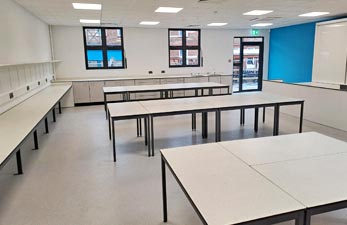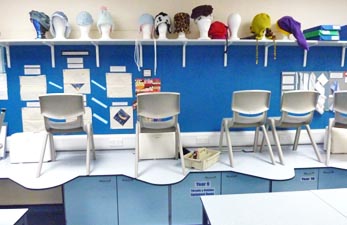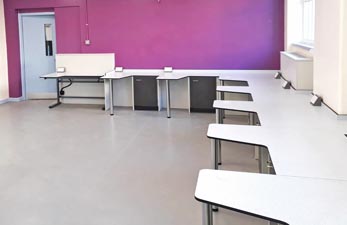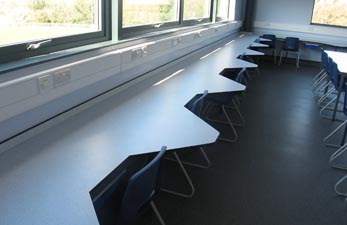08 Jun Textile Room Design – Guidelines for Schools & Colleges
Any textile room design should accommodate a range of activities, these could include designing, printing and the construction of garments.


Large sinks are necessary for any dyeing and printing of fabric. These would usually be accommodated away from the sewing or design areas and have a splashback.
Storage of equipment is required and it is best to keep sewing machines and weaving equipment in a storeroom, which can double up as a changing room and therefore plenty of space should be allowed. Fabric rolls and finished garments will need to be stored and there should be space allocated for tailor’s dummies.
Space should also be allowed for cutting out tables and these tables may also be used for theory lessons.
Worktops for Textiles Rooms
Worktops made from particle board or laminate can chip or splinter easily on impact.
We recommend a hard wearing worksurface such as Trespa which will withstand the wear and tear of sewing machines and other equipment being moved around the room and from storerooms.
A robust design of workbench will also help to minimise vibrations and remain stable when a sewing machine is used at high speed.
Worktop Heights for Textiles Rooms
Cutting out tables would usually be specified at 850mm high and it might be tempting to opt for sewing machine benching to be at that height to allow for the same stools to be used for both activities. However we recommend a work top height for sewing machine benching of 720mm, otherwise students can’t reach the sewing machine foot pedals.
If there is no space for extra stools it is preferable to opt for all the benches to be at the same height of 720mm.
Testimonial
“Klick Technology supplied and installed the educational furniture for the refurbishment of the textiles classroom at Braunton Academy. They provided a personal and professional service from conception to completion and I was thoroughly impressed with their attention to detail both in the layout design and the finished product. This was a particular achievement as they were working to some very tight timescales and deliverability was a key issue for the School. Klick’s performance was excellent and I would wholeheartedly recommend them for future school projects.”
Kay Treganna – Project Architect, TFQ Architects – Re Braunton AcademyClick here for additional case study details for Braunton Academy’s textiles room design.
Saw Tooth Benching for Sewing Machines


Saw-tooth benching allows for students to work at an angle giving them greater elbow room which is particularly beneficial in avoiding a clash with left and right-handed users. This style of benching creates an individual work area and makes the most of the available space. Also, fabric can be draped freely over the back of the sewing machine making it easier to work with larger fabric lengths.
Recent Interest in Sewing and Textiles
There has been a renewed interest in sewing perhaps influenced by the success of programmes such as the Great British Sewing Bee which champions the restyling of old fashion items to give them a new lease of life.
John Lewis has reported that its sewing and dyeing products have seen a huge increase in sales as shoppers adopt a “make do and mend” approach.
Sales of craft and repair items for John Lewis are up 61% compared to last year as customers are updating or repairing clothing rather than throwing it away.
Support for Schools in Teaching Textiles
Textiles is part of the Design and Technology department in schools and support is offered by The Design and Technology Association which promotes high-quality design and technology teaching and learning as an essential part of the rounded education of all young people. They link schools and students with the world of business, manufacturing and industry and lobby government and key decision-makers to ensure that the subject’s value is duly recognised and supported.
If you are planning to update your textiles facilities our consultants can offer advice on room layout and design. Please call 0161 9989726 or email us to discuss your plans.
Resources and Further Reading
Building Bulletin 81 – https://science.cleapss.org.uk/resource/building-bulletin-81-design-technology.pdf
The Great British Sewing Bee – https://www.thegreatbritishsewingbee.co.uk/
Prima – https://www.prima.co.uk/craft/sewing/a42530592/john-lewis-reveals-rise-in-haberdashery-sales/
The Design & Technology Association – https://www.designtechnology.org.uk/


